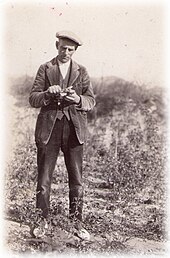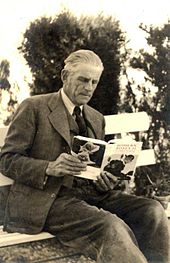Pedro Dot

Pedro Dot ( cat.Pere Dot i Martínez ; March 28, 1885 in Monistrol de Montserrat - November 12, 1976 ) was a Spanish rose breeder .
Life
Pedro Dot was born in 1885 on the Monistrol country estate near Barcelona , where his father was the administrator. Back then a rose cultivation company, the country estate is now a winery that is known for its sparkling wine. Dot's first experiments with hybrid roses were supported by the Duchess of Monistrol (also: Sástago).
The Duchess loaned him money to start his business, only to be rewarded at the end with the dedication of one of his best roses. His father Simon came from a family of farm workers, but had made it to a well-known gardener and plant breeder. Despite the very alkaline soil, he had set up a small horticultural business near Sant Feliu de Llobregat , where the family company Rosas Dot can still be found today. Pedro initially took care of the roses, later he took over the entire company. This then moved to Vilafranca del Penedès on the other side of Barcelona , whereby the location in San Feliu de Llobregat was retained. At the age of 16 Pedro started his apprenticeship in another company, in 1910 he went to Belgium and Paris, where he got to know new methods of hybridization - and also the French attitude to garden art. In order not only to be dependent on the market for garden culture, which is quite small in Spain, he started looking for customers all over the world.
As early as 1924 Dot exhibited his new varieties at international competitions, with his Margarita Riera breeding winning a performance award at the “International Competition of New Roses” ( Concours international de roses nouvelles de Bagatelle in the Parc de Bagatelle ) in Paris . He used rare varieties such as Frau Karl Druschki , Souvenir de Claudius Pernet and Mme Edouard Herriot to produce a large number of colorful tea hybrids , which were particularly effective in warm climates. Most of these varieties are descended from Pernetiana - Joseph Pernet-Ducher was the first to breed the intense yellow color and strong smell of Rosa foetida into the hybrid tea - and are not frost-resistant. Marí Dot won a prize in Strasbourg, Condesa de Sástago first prize in Rome; later it became very popular in the United States. It was the first successful two-tone rose, with petals scarlet on the front and yellow on the back. Conard Pyle Co. imported many of these roses into the United States under their original names, although few appear to have been patented. From 1925, Dot also began using the pollen from wild roses in his farms.
Without a doubt, Dot's most successful breed was the Nevada Rose , released in 1927 - a hybrid Bibernell rose ( Rosa spinosissima ). The Mme Grégoire Staechlin climbing rose was created in the same year. Given that a grower had to choose from tons of seedlings, Dot continued to look for roses that were wilder and more extreme in character than their parents. In this way he approached the expressionism of his Catalan compatriot Antoni Gaudí . Dot also renewed the moss rose tradition with the Golden Moss rose (1932), the first yellow moss rose ever grown.
In the 1930s, Dot successfully built on the work of Pernet-Ducher to grow a number of flamed roses, from pastels to strong oranges. Examples are the varieties Catalonia , Condesa de Sástago , Angels Mateu , Girona , Maria Peral , Duquesa de Peñaranda and Federico Casas . With Baby Gold Star , Golden Sástago and Joaquin Mir , Dot achieved real, deep yellows.
He was a member of the "Amigos de las Rosas" (Rose Friends), which he founded in Barcelona in 1931 together with Rubio, Cambo, Ros Sabaté and Cyprien Camprubí, the breeder of the well-known Violonista Costa . His pupil Eugenio Fojo became known in northern Spain.
Dot received support from the Republican government of Barcelona during the Spanish Civil War, as well as donations from Conard-Pyle and American rose lovers. Even if his sons Simon and Marí fought for the later defeated Republicans, his company was protected from the victorious nationalists around Franco with American support and funding . During the Civil War and the following twenty years, Dot hybridized miniature roses, revolutionizing the field. His breeding approach was to cross hybrid tea and miniature roses and thus obtain more robust varieties than other breeders who used polyantha roses .
Pedro Dot was the most famous Spanish rose grower until he was succeeded by his son Simon in the 1960s and was particularly successful with purple roses. His other son Marino and two of his grandchildren also grew roses in the 1960s and 1970s, and some of their roses were mistakenly attributed to him because of Pedro's greater fame.
Pedro Dot died on November 12, 1976.
Names and dedications of the roses
Until the Second World War , it can be said that every name of a rose by Dot corresponded to a dedication. In the 1920s the roses were mostly dedicated to family members ( Marí Dot ) and aristocratic patrons ( Cayetana Stuart ), in the republican period to Catalan patriots ( Angel Guimera ) and republican cities that had not yet been conquered by the nationalists ( Lleida , Girona ), later international supporters ( Senateur Potié ) and Catalan patriots who died in the war ( Ramon Bach ). After the Second World War, however, the roses were mostly named after international celebrities and tourist locations.
Survival of the life's work
Nevada and Mme Grégoire Staechlin are sure to endure in the future and Dots miniature roses are safe with their lovers. His hybrid teas are problematic, and while his company continues to have around 60 varieties for sale, only 10 are from Dot itself. Some varieties continue to be sold in the United States by horticultural companies like Vintage Gardens in California - where these varieties also feel good climatically. A handful of varieties survive in public gardens, such as the Roseraie de L'Haÿ near Paris and the Roseraie François Mitterrand in southern France. Fortunately there are still 66 of his varieties in the Fineschi encyclopedic collection in Italy and another 32 in the Europa-Rosarium in Sangerhausen . But many of his total of around 140 tea hybrids - one of the greatest lifeworks of a rose grower - depend on individual private collectors in Spain. The beautiful Angelita Ruaix, for example, is kept on a balcony in Barcelona by the elderly daughter of the namesake.
Australian collections contain at least the hybrid tea roses Cascabel , Catalònia , Condesa de Sástago , Duquesa de Peñeranda , Frivolité , Girona , Golden Moss , Lady Trent ( Julia Ferran ), Linda Porter ( Miguel Andrufeu ), Lola Montes , Mme Grégoire Staechelin , Nevada , Pilarin Vilella and Rádio . There are also a number of miniature roses there.
Individual evidence
- ↑ Geneall . Retrieved January 23, 2013.
- ↑ According to Jaume Garcia i Urpi, Amics de les Roses de Sant Feliu de Llobregat.
- ↑ AS Thomas: Growing roses: the complete guide to growing & showing roses in Australia . Nelson, Melbourne 1983, ISBN 0-17-006188-4 , p. 50.
- ↑ Bunny Skran, "Pedro Dot and the Spanish tradition," American Rose , 1999, pp 30-33.
- ^ Roger Phillips & Martyn Rix, The Quest for the Rose , BBC Books, 1993, p. 206. ISBN 0-563-36442-4 .
-
^ Charles Quest-Ritson: Climbing Roses of the World . Timber Press, 2003, ISBN 0-88192-563-2 , p. 239. Also "Pedro Dot" in Charles & Brigid Quest-Ritson: Encyclopedia of roses . Dorling-Kindersley, New York 2011, ISBN 978-0-7566-8868-4 , p. 122.
- ^ Charles & Brigid Quest-Ritson, The RHS Encyclopaedia of Roses, Dorling Kindersley, 2003, p. 122. ISBN 978-1-4053-3511-9 .
- ↑ Jean Lewis, "Depression-Era Roses," Rosa Mundi , Autumn 2009 – Winter 2010, p. 55. Available online as Depression-era Roses at Heritage Rose Foundation ( Memento of the original from July 26, 2011 in the Internet Archive ) Info: The archive link was inserted automatically and has not yet been checked. Please check the original and archive link according to the instructions and then remove this notice. (engl.)
- ↑ Catalunya, Terra de roses , 1999, Diputació de Barcelona (span.), ISBN 84-7794-621-3
- ↑ Peter Harkness, "Notable Rose Breeders", entry for Dot, Pedro and Simon, p. 678 in: Peter Beales et al., Botanica's Roses: the Encyclopaedia of Roses , 1998, Random House. ISBN 0-09-183592-5 .
Web links
- Website of Rosas Dot , the family business
-
Enciclopedia Roses : A comprehensive online encyclopedia of Catalan roses, including those of the Dot family, compiled (Catalan) by the Amics des Roses de Sant Feliu de Llobregat (Rose Friends of Sant Feliu).
- Here is an example of the entry for Marí Dot
- Jaume Garcia, La rosa Àngels Mateu i el castell de Peralada (The Rose Àngels Mateu and the Castle of Peralada, Catalan), accessed April 12, 2017
Family pictures
| personal data | |
|---|---|
| SURNAME | Dot, Pedro |
| ALTERNATIVE NAMES | Dot i Martínez, Pere |
| BRIEF DESCRIPTION | Spanish rose grower |
| DATE OF BIRTH | March 28, 1885 |
| PLACE OF BIRTH | Monistrol de Montserrat |
| DATE OF DEATH | November 12, 1976 |





